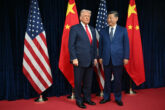April 26, 2022
Creating Waves in the Indo-Pacific: Reverberations from Russia’s War in Ukraine
Russia’s war in Ukraine—which was preceded by the announcement of a historical pact between Moscow and Beijing on February 4—will have far-reaching global strategic implications, particularly in the Indo-Pacific where China’s growing influence is already shifting the regional order. The situation is still playing out with all eyes focused on whether China will provide Russia military support or bail out the Russian economy as it is increasingly squeezed by western sanctions.
US President Joe Biden’s Indo-Pacific strategy document gives a clear indication of the value the US places on its strategic partnership with India and its vision for New Delhi to play a central role in this vital region that is increasingly subject to Chinese aggression and coercion. However, Russia’s invasion of Ukraine and India’s disappointing response has raised questions about India’s overall reliability as a strategic partner of the US and its adaptability to consequential global developments that require leadership and unity among democratic powers.
U.S. President Joe Biden’s Indo-Pacific strategy document gives a clear indication of the value the US places on its strategic partnership with India and its vision for New Delhi to play a central role in this vital region that is increasingly subject to Chinese aggression and coercion.
US Prioritises Indo-Pacific
The White House Indo-Pacific strategy—released one week after the Moscow-Beijing Joint Statement and two weeks before Russia invaded Ukraine—makes clear that the defining long-term national security priority for the US remains strategic competition with China. The strategy was forthright about the threats and challenges posed by a rising and increasingly aggressive China yet also focused on an affirmative US agenda with the goal of sustaining the region’s free, open, transparent, and inclusive order. While Russian aggression in Eastern Europe demands Washington’s immediate attention, US policymakers remain keenly aware that China could use the crisis in Ukraine to undermine American influence in the Indo-Pacific and establish itself as the undisputed regional hegemon.
Just as the Trump administration’s Indo-Pacific Strategic Framework singled out India for an important role, so too does Biden’s strategy highlight the US-India bilateral relationship as a major component of its overall Indo-Pacific strategy. Former US President Donald Trump’s framework was more explicit about the US goal to accelerate India’s rise, while Biden’s strategy recognises India as a “leader in South Asia and the Indian Ocean, active in and connected to Southeast Asia, a driving force of the Quad and other regional fora, and an engine for regional growth and development.”
Read the full article from The Observer Research Foundation.
More from CNAS
-
North Korea Reveals Troop Dispatch to Russia amid U.S.-South Korea Policy Talks
North Korea has confirmed for the first time that its troops are operating in Russia, and it is preparing to rewrite its party charter with the possibility of officially namin...
By Dr. Go Myong-Hyun
-
Chinese Maker of Bitcoin-Mining Machines Is a Security Threat, Says Expert
Bloomberg News reports that a Chinese manufacturer, Bitmain Technologies Ltd, that sells most of the world’s Bitcoin-mining machines — including 16,000 of them to a venture ba...
By David Feith
-
Indo-Pacific Security / Energy, Economics & Security
North Korea’s Provocations, Power Plays, and Shifting AlliancesTensions on the Korean Peninsula have reached a new and dangerous threshold. President Lee Jae Myung is warning of a real risk of accidental military clashes, as the situation...
By Dr. Go Myong-Hyun
-
Indo-Pacific Security / Energy, Economics & Security
How to Win the Economic War with ChinaTrump's approach to China has run aground, giving Beijing unprecedented advantage in the economic conflict....
By Edward Fishman & Julian Gewirtz



